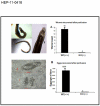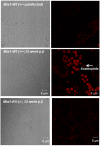The metastasis-associated protein-1 gene encodes a host permissive factor for schistosomiasis, a leading global cause of inflammation and cancer
- PMID: 21488078
- PMCID: PMC3125413
- DOI: 10.1002/hep.24354
The metastasis-associated protein-1 gene encodes a host permissive factor for schistosomiasis, a leading global cause of inflammation and cancer
Abstract
Schistosoma haematobium is responsible for two-thirds of the world's 200 million to 400 million cases of human schistosomiasis. It is a group 1 carcinogen and a leading cause of bladder cancer that occurs after years of chronic inflammation, fibrosis, and hyperproliferation in the host liver. The coevolution of blood flukes of the genus Schistosoma and their human hosts is paradigmatic of long-term parasite development, survival, and maintenance in mammals. However, the contribution of host genes, especially those discrete from the immune system, necessary for parasite establishment and development remains poorly understood. This study investigated the role of metastasis-associated protein-1 gene (Mta1) product in the survival of S. haematobium and productive infection in the host. Using a Mta-1 null mouse model, here we provide genetic evidence to suggest that MTA1 expression positively influences survival and/or maturation of schistosomes in the host to patency, as we reproducibly recovered significantly fewer S. haematobium worms and eggs from Mta1-/- mice than wild-type mice. In addition, we found a distinct loss of cytokine interdependence and aberrant Th1 and Th2 cytokine responses in the Mta1-/- mice compared to age-matched wild-type mice. Thus, utilizing this Mta1-null mouse model, we identified a distinct contribution of the mammalian MTA1 in establishing a productive host-parasite interaction and thus revealed a host factor critical for the optimal survival of schistosomes and successful parasitism. Moreover, MTA1 appears to play a significant role in driving inflammatory responses to schistosome egg-induced hepatic granulomata reactions, and thus offers a survival cue for parasitism as well as an obligatory contribution of liver in schistosomiasis.
Conclusion: These findings raise the possibility to develop intervention strategies targeting MTA1 to reduce the global burden of schistosomiasis, inflammation, and neoplasia.
Copyright © 2011 American Association for the Study of Liver Diseases.
Figures







Similar articles
-
Inflammatory response to liver fluke Opisthorchis viverrini in mice depends on host master coregulator MTA1, a marker for parasite-induced cholangiocarcinoma in humans.Hepatology. 2011 Oct;54(4):1388-97. doi: 10.1002/hep.24518. Epub 2011 Sep 6. Hepatology. 2011. PMID: 21725997 Free PMC article.
-
A novel mouse model of Schistosoma haematobium egg-induced immunopathology.PLoS Pathog. 2012;8(3):e1002605. doi: 10.1371/journal.ppat.1002605. Epub 2012 Mar 29. PLoS Pathog. 2012. PMID: 22479181 Free PMC article.
-
Strongyloides venezuelensis-infection alters the profile of cytokines and liver inflammation in mice co-infected with Schistosoma mansoni.Cytokine. 2020 Mar;127:154931. doi: 10.1016/j.cyto.2019.154931. Epub 2019 Nov 26. Cytokine. 2020. PMID: 31783260
-
T Lymphocyte-Mediated Liver Immunopathology of Schistosomiasis.Front Immunol. 2020 Feb 18;11:61. doi: 10.3389/fimmu.2020.00061. eCollection 2020. Front Immunol. 2020. PMID: 32132991 Free PMC article. Review.
-
The C-type Lectin Receptor-Driven, Th17 Cell-Mediated Severe Pathology in Schistosomiasis: Not All Immune Responses to Helminth Parasites Are Th2 Dominated.Front Immunol. 2019 Jan 30;10:26. doi: 10.3389/fimmu.2019.00026. eCollection 2019. Front Immunol. 2019. PMID: 30761125 Free PMC article. Review.
Cited by
-
Metastasis-associated protein 1/nucleosome remodeling and histone deacetylase complex in cancer.Cancer Res. 2012 Jan 15;72(2):387-94. doi: 10.1158/0008-5472.CAN-11-2345. Cancer Res. 2012. PMID: 22253283 Free PMC article. Review.
-
Break Out: urogenital schistosomiasis and Schistosoma haematobium infection in the post-genomic era.PLoS Negl Trop Dis. 2013;7(3):e1961. doi: 10.1371/journal.pntd.0001961. Epub 2013 Mar 28. PLoS Negl Trop Dis. 2013. PMID: 23556007 Free PMC article. No abstract available.
-
Pancreatic Leiomyosarcoma With Schistosomiasis Hematobia: A Case Report and Literature Review.Front Oncol. 2021 Mar 31;11:638905. doi: 10.3389/fonc.2021.638905. eCollection 2021. Front Oncol. 2021. PMID: 33869026 Free PMC article.
-
The Opisthorchis viverrini genome provides insights into life in the bile duct.Nat Commun. 2014 Jul 9;5:4378. doi: 10.1038/ncomms5378. Nat Commun. 2014. PMID: 25007141 Free PMC article.
-
Effects of Schistosoma haematobium infection and treatment on the systemic and mucosal immune phenotype, gene expression and microbiome: A systematic review.PLoS Negl Trop Dis. 2024 Sep 9;18(9):e0012456. doi: 10.1371/journal.pntd.0012456. eCollection 2024 Sep. PLoS Negl Trop Dis. 2024. PMID: 39250522 Free PMC article.
References
-
- van der Werf MJ, de Vlas SJ, Brooker S, Looman CW, Nagelkerke NJ, Habbema JD, Engels D. Quantification of clinical morbidity associated with schistosome infection in sub-saharan africa. Acta Trop. 2003;86:125–139. - PubMed
-
- Parkin DM. The global health burden of infection-associated cancers in the year 2002. Int J Cancer. 2006;118:3030–3044. - PubMed
-
- Pearce EJ, MacDonald AS. The immunobiology of schistosomiasis. Nat Rev Immunol. 2002;2:499–511. - PubMed
Publication types
MeSH terms
Substances
Grants and funding
LinkOut - more resources
Full Text Sources
Other Literature Sources
Medical
Research Materials
Miscellaneous
